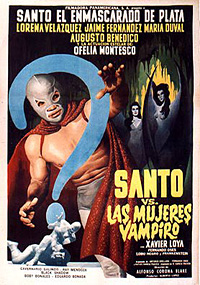
|  |  |  News Around the Republic of Mexico | September 2008 News Around the Republic of Mexico | September 2008  
Origin of Nacho Libre
 Monica Cruz - OColly Monica Cruz - OColly
go to original


| | During the 1960s, El Santo starred in a series of low-budget science fiction films. "Santo v. the Vampire Women", "Santo v. the Zombies" and "Santo v. the Mummies" are some of the most popular titles. | | |
Wrestling fans across Mexico celebrated the 75th anniversary of "Lucha Libre" (free fight) Friday. Mexican wrestling is more than just a sport.

It has become a national tradition that unites people regardless of age, education and social status. As for the rest of the world, Lucha Libre is a cultural icon that represents Mexican identity in a vast globalized society.

Going to a Mexican wrestling match is like going to a massive party. Food is everywhere, from popcorn, chips and sodas to shrimp cocktails; there’s a food stand for any sort of craving. People shout not only to the wrestlers but also to the audience. Lucha Libre Arenas are definitely not places for people sensitive to colorful language. Some people in the audience sacrificed their family savings to buy front row tickets while others found them really cheap. However, people forget their differences and personal problems to join a loud, sweaty, thrilling and even bloody ritual.

Just like any other DC or Marvel super hero, all-time favorite Mexican wrestlers like El Santo (the Saint) and Blue Demon have double identities, wear fancy and colorful masks, boots, pants and capes, and impress the ladies, even when they carry a few extra pounds. They also fight against crime between matches, not in real life, but in films and comic books. In recent years, wrestlers have regained their place among Mexican children as their ultimate super heroes.

Throughout 75 years, Mexican wrestling has created an industry of films, comic books, toys, fashion and folk art that has transcended Mexican boundaries. During the 1960s, El Santo starred in a series of low-budget science fiction films. "Santo v. the Vampire Women", "Santo v. the Zombies" and "Santo v. the Mummies" are some of the most popular titles. Although these films usually provoke unintended humor, French and U.S. film fans believed their cinematography had a touch of surrealism, which I think their creators were not aware of.

The cultural and ethnic convergence in the U.S. has given Lucha Libre a prominent place in pop culture. Cartoon Network’s "Mucha Lucha!" and Jack Black’s "Nacho Libre" are some examples of Mexican culture’s strong presence in the U.S. and the representation of the Hispanic community in the main stream media. Though a little stereotyped, it’s at least taken into consideration.

Embracing our cultural differences is the best way to avoid becoming Orwellian uniformed masses. I’m not a hardcore Lucha Libre fan, but it’s popularity outside Mexico has made me want to watch El Santo films, go to matches in Puebla and Mexico City and learn more about wrestlers and their signature techniques. I would certainly take my foreign friends to a Lucha Libre match.

I bet that would be an experience they would tell to their grandchildren. |

 |
|  |



